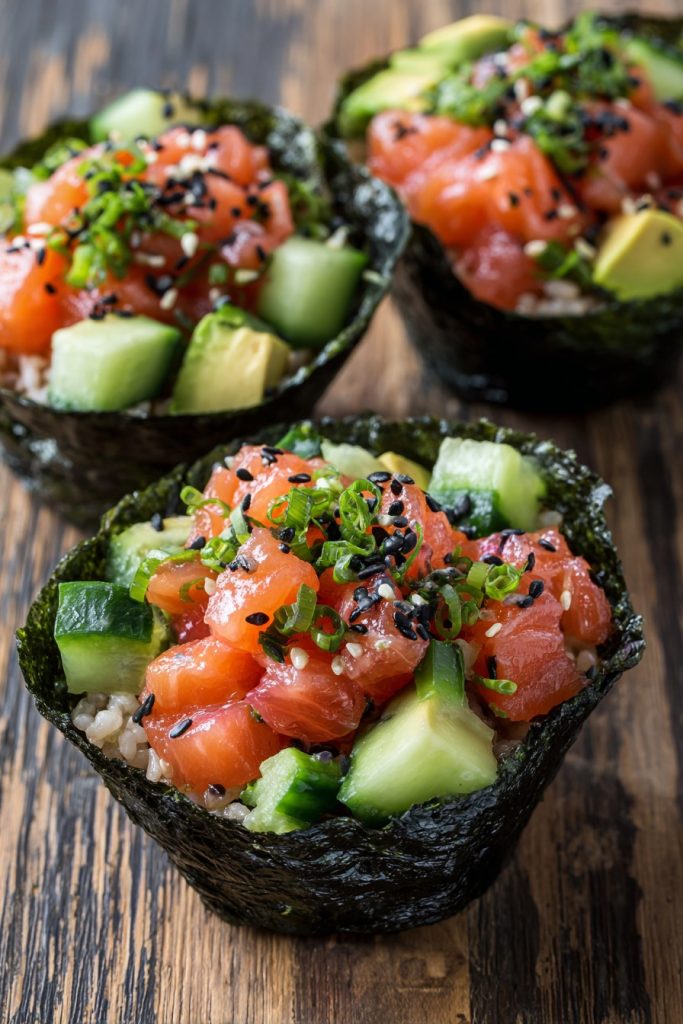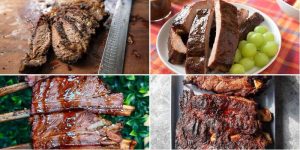Vibrant and nutrient-dense, these salmon sushi cups revolutionize traditional sushi by transforming it into convenient, individual portions perfect for health-conscious eaters. Versatile enough for meal prep or elegant entertaining, they deliver all the authentic flavors of sushi with simplified preparation that eliminates the need for rolling skills. Very approachable for home cooks, this recipe maintains the nutritional integrity of high-quality ingredients while offering creative customization options.
Why This Recipe Works
- Nutrient Optimization: Wild-caught salmon provides exceptional omega-3 fatty acids that support cardiovascular health and cognitive function, while short-grain brown rice offers more fiber and minerals than traditional white sushi rice, creating a balanced macronutrient profile that sustains energy levels throughout the day.
- Time Efficiency: By eliminating the traditional rolling process, these cups cut preparation time significantly while maintaining authentic sushi flavors, making them accessible for busy weeknights without compromising on quality or nutritional value.
- Portion Control: Individual cup servings provide built-in portion management, helping prevent overeating while allowing for precise calorie counting and macronutrient tracking for those monitoring their dietary intake.
- Digestive Benefits: The combination of fermented rice vinegar and ginger in the seasoning offers natural digestive support, while the high-quality protein and healthy fats promote sustained satiety and stable blood sugar levels.
- Customization Flexibility: The cup format allows for endless variations to accommodate different dietary preferences and nutritional goals, from keto-friendly cauliflower rice bases to plant-based protein alternatives.
Ingredients
- 1 pound fresh wild-caught salmon fillet, skin removed and finely diced
- 2 cups cooked short-grain brown rice, cooled to room temperature
- 3 tablespoons rice vinegar
- 1 tablespoon raw honey or maple syrup
- 1 teaspoon sea salt
- 1 medium English cucumber, finely diced with seeds removed
- 1 large avocado, peeled and cubed
- 2 tablespoons tamari or coconut aminos
- 1 teaspoon toasted sesame oil
- 2 sheets nori seaweed, cut into 2-inch squares
- 1 tablespoon pickled ginger, finely chopped
- 2 green onions, thinly sliced
- 1 tablespoon black sesame seeds for garnish
- 1 teaspoon wasabi paste (optional)
Equipment Needed
- 12-cup standard muffin tin
- Medium mixing bowl
- Small saucepan
- Sharp chef’s knife
- Cutting board
- Measuring cups and spoons
- Rubber spatula
- Small whisk
Instructions

Prepare the Sushi Rice Seasoning
Begin by creating the traditional sushi rice seasoning that forms the flavor foundation of your cups. In a small saucepan over medium-low heat, combine 3 tablespoons of rice vinegar, 1 tablespoon of raw honey or maple syrup, and 1 teaspoon of sea salt. Heat this mixture gently for 2-3 minutes, stirring constantly with a small whisk until the sweetener and salt completely dissolve into the vinegar. The liquid should reach approximately 120°F but should never come to a boil, as excessive heat can destroy the delicate probiotic benefits of the vinegar. Remove from heat and allow the seasoning to cool to room temperature, which typically takes about 10-15 minutes. This cooling period is crucial because adding warm seasoning to cooked rice can create a gummy texture. For optimal flavor development, the rice vinegar mixture should be completely cool before incorporating it into the rice to ensure proper absorption and distribution of flavors throughout each grain.
Season and Prepare the Rice Base
Assemble the Sushi Cup Bases
Lightly grease your standard 12-cup muffin tin with a neutral oil spray or brush with sesame oil to prevent sticking. Place one 2-inch square of nori seaweed into each muffin cup, pressing it gently against the bottom and sides to form a liner. Using a tablespoon measure, portion approximately 3 tablespoons of the seasoned rice mixture into each nori-lined cup. With damp fingers or the back of a spoon, firmly press the rice into an even layer across the bottom and slightly up the sides, creating a well in the center for the filling. Apply consistent pressure to ensure the rice packs tightly enough to hold its shape when unmolded but not so hard that it becomes dense and heavy. The rice layer should be approximately 1/4-inch thick on the bottom and sides, with the center depression deep enough to accommodate the salmon and vegetable fillings. This structural foundation is crucial for maintaining the cup shape during serving and eating.
Prepare the Salmon and Vegetable Fillings
Ensure your 1 pound of fresh wild-caught salmon fillet is completely free of skin and any dark bloodlines before beginning. Using a sharp chef’s knife, dice the salmon into 1/4-inch cubes, working quickly to minimize handling and maintain the fish’s delicate texture. In a separate bowl, combine the diced salmon with 2 tablespoons of tamari or coconut aminos and 1 teaspoon of toasted sesame oil, gently tossing to coat each piece evenly without breaking down the fish. Let this marinate for exactly 5 minutes at room temperature – any longer and the acid in the tamari will begin to chemically cook the salmon. Meanwhile, prepare your vegetables by dicing 1 medium English cucumber (seeds removed) and cubing 1 large avocado, then combining them in another bowl with 1 tablespoon of finely chopped pickled ginger and 2 thinly sliced green onions. Keep the fillings separate until assembly to maintain distinct textures and flavors in the final presentation.
Layer Fillings and Final Assembly
Begin the assembly process by dividing the marinated salmon mixture evenly among the 12 prepared rice cups, using approximately 2 tablespoons per cup. Gently press the salmon into the rice base without compacting it too firmly, as you want to maintain the delicate texture of the fish. Next, layer the cucumber and avocado mixture over the salmon, filling each cup to just below the rim of the nori liner. The vegetables should create a colorful top layer that contrasts beautifully with the pink salmon beneath. Sprinkle each cup with a pinch of black sesame seeds for visual appeal and additional nutritional benefits, including calcium and antioxidants. Professional Tip: For optimal food safety, assemble the cups no more than 2 hours before serving and keep refrigerated until ready to eat. The completed cups can be served immediately or chilled for up to 2 hours to allow flavors to meld while maintaining optimal texture and food safety standards.
Tips and Tricks
For those seeking to elevate their salmon sushi cups to restaurant-quality standards, several advanced techniques can significantly improve both flavor and presentation. When selecting salmon, prioritize wild-caught varieties from sustainable fisheries, as they typically contain higher concentrations of omega-3 fatty acids and lower levels of environmental contaminants compared to farmed alternatives. The texture of wild salmon also tends to be firmer and more suitable for dicing. If using previously frozen salmon, ensure it’s completely thawed in the refrigerator overnight rather than at room temperature to prevent bacterial growth and texture degradation. For the rice component, consider soaking short-grain brown rice for 30 minutes before cooking to reduce phytic acid content and improve mineral absorption, then cook using the absorption method with a 1:1.25 rice-to-water ratio for optimal texture. The rice should be slightly firmer than usual since it will continue to absorb moisture from the other ingredients during assembly and resting. When working with nori sheets, keep them in an airtight container until ready to use to maintain crispness, and consider briefly passing them over a gas flame (2-3 seconds per side) to enhance their flavor and aroma before cutting into squares. For food safety considerations, always use separate cutting boards and utensils for raw fish and vegetables to prevent cross-contamination, and work in a cool kitchen environment (below 70°F) when handling raw salmon. If serving to individuals with compromised immune systems, you may substitute lightly seared or quick-marinated salmon instead of completely raw. To achieve perfect unmolding, run a small offset spatula or butter knife around the edge of each cup before gently lifting them from the muffin tin. For make-ahead convenience, you can prepare the seasoned rice and chop vegetables up to 24 hours in advance, storing them separately in airtight containers in the refrigerator, then assemble the cups just before serving. Leftover assembled cups can be stored for up to 24 hours, though the nori will soften considerably, changing the textural experience.
Recipe Variations
- Protein Alternatives: For those who prefer cooked seafood or different protein sources, substitute the raw salmon with 1 pound of lightly seared ahi tuna, cooked shrimp, or even smoked salmon. Vegetarian options include marinated baked tofu cubes, tempeh crumbles, or heart of palm finely diced to mimic seafood texture. Each alternative provides distinct nutritional benefits – tofu offers complete plant-based protein with isoflavones, while smoked salmon provides convenience without sacrificing omega-3 content.
- Grain-Free Base: Replace the brown rice with cauliflower rice for a low-carb, grain-free alternative that aligns with ketogenic and paleo dietary patterns. To prepare, pulse 1 large head of cauliflower in a food processor until rice-like consistency forms, then sauté in 1 tablespoon of coconut oil for 5-7 minutes until tender but not mushy. Season with the same vinegar mixture, though you may need to reduce the quantity by one-third since cauliflower absorbs liquid differently than rice.
- Flavor Enhancements: Incorporate different cultural flavor profiles by modifying the seasoning components. For a Japanese-inspired twist, add 1 teaspoon of yuzu juice to the rice seasoning. For a Korean fusion version, mix 1 tablespoon of gochujang into the salmon marinade and garnish with kimchi. Mediterranean variations could include substituting the salmon with grilled Mediterranean sea bass and adding chopped kalamata olives and fresh dill to the vegetable mixture.
- Allergy Accommodations: For shellfish allergies, ensure your nori is certified pure seaweed without any cross-contamination risk. Soy-free diets can use coconut aminos exclusively instead of tamari, while those avoiding sesame can substitute the oil with avocado oil and omit the sesame seed garnish. Gluten-free needs are naturally accommodated by this recipe when using tamari rather than traditional soy sauce.
Frequently Asked Questions
Can I use frozen salmon for this recipe?
Yes, frozen salmon can be used effectively if proper thawing techniques are followed. The FDA actually recommends using previously frozen fish for raw preparations, as the freezing process destroys potential parasites. Thaw the salmon gradually in the refrigerator for 24 hours before using, never at room temperature. Once thawed, pat it completely dry with paper towels before dicing to prevent excess moisture from making your cups soggy. Quality frozen wild salmon often matches or exceeds fresh options in nutritional value since it’s typically frozen immediately after catch, preserving omega-3 content. However, avoid refreezing previously thawed salmon, as this can compromise texture and food safety.
How long do these sushi cups last in the refrigerator?
Properly stored in an airtight container, assembled sushi cups maintain optimal quality for up to 24 hours, though the nori will soften considerably. For best texture, I recommend consuming them within 4 hours of assembly. If you need longer storage, prepare components separately and assemble just before serving. The seasoned rice alone can be refrigerated for 3-4 days, while the diced vegetables and marinated salmon (kept separate) will last 1-2 days. Always trust your senses – if anything develops an off odor, unusual sliminess, or discoloration, discard immediately. Never freeze assembled sushi cups, as freezing destroys the delicate textures of both the rice and raw fish.
What are the health benefits of using brown rice instead of white?
Brown rice retains the bran and germ layers that white rice loses during milling, making it nutritionally superior in several key areas. It contains significantly more fiber – approximately 3.5 grams per cup compared to less than 1 gram in white rice – which supports digestive health and promotes satiety. The bran layer also provides essential minerals like magnesium, selenium, and manganese in higher concentrations, along with B vitamins crucial for energy metabolism. Brown rice has a lower glycemic index, meaning it causes slower, more gradual rises in blood sugar compared to white rice. Additionally, the phytonutrients in the bran layer offer antioxidant protection. The trade-off is a slightly chewier texture and nuttier flavor that some traditional sushi purists might find different from expectations.
Can I make these sushi cups vegan?
Absolutely! For a completely plant-based version, replace the salmon with marinated watermelon cubes that mimic the texture of raw fish when prepared correctly. Cut seedless watermelon into 1/2-inch cubes and marinate in 2 tablespoons of tamari, 1 teaspoon of rice vinegar, 1/2 teaspoon of nori flakes, and 1/4 teaspoon of smoked paprika for 30 minutes. Alternatively, use seasoned king oyster mushrooms sliced thin and briefly marinated, or pressed extra-firm tofu cubed and marinated in the same mixture used for salmon. The remaining ingredients naturally align with vegan diets when you ensure your nori contains no fish-based seasonings and use maple syrup instead of honey in the rice seasoning. These substitutions create a nutrient-dense plant-based option rich in fiber, antioxidants, and plant proteins.
Summary
These innovative salmon sushi cups transform traditional sushi into accessible, nutrient-dense individual portions perfect for health-conscious eating. Combining omega-3 rich wild salmon with fiber-packed brown rice and fresh vegetables, they deliver balanced nutrition with authentic flavors. The simplified assembly eliminates rolling skills while offering endless customization possibilities for various dietary preferences and nutritional goals.
Salmon Sushi Cups
12
servings25
minutesIngredients
Instructions
- 1 In small saucepan, combine rice vinegar, honey, and salt. Heat gently over medium-low for 2-3 minutes until dissolved, then cool completely.
- 2 Transfer cooked rice to bowl, add cooled vinegar mixture, and fold gently to combine. Let rest 10 minutes.
- 3 Press nori squares into greased muffin tin cups. Add 3 tablespoons seasoned rice to each, pressing to form cups.
- 4 Combine diced salmon with tamari and sesame oil. Marinate 5 minutes.
- 5 Mix cucumber, avocado, ginger, and green onions in separate bowl.
- 6 Layer salmon then vegetable mixture into rice cups. Garnish with sesame seeds and serve immediately.



